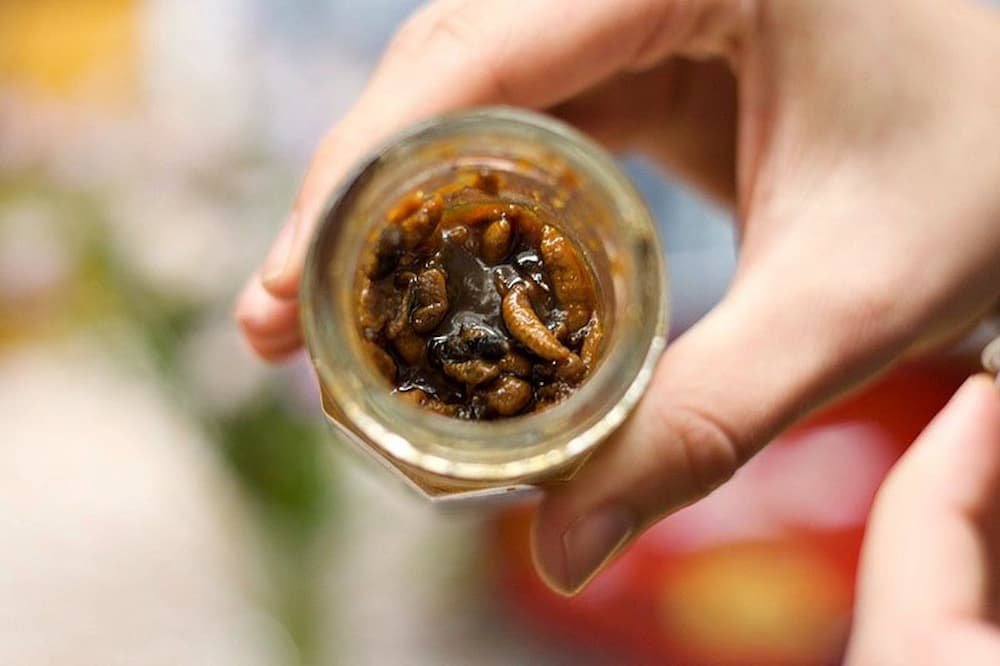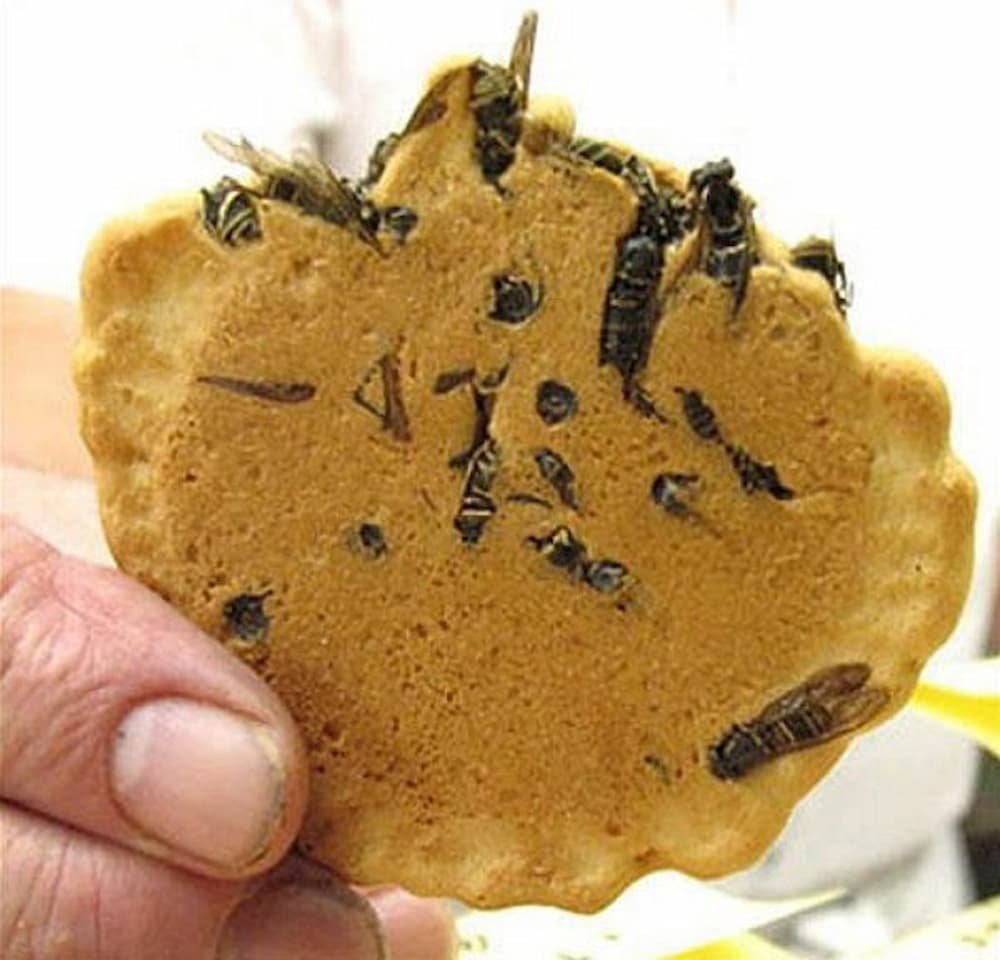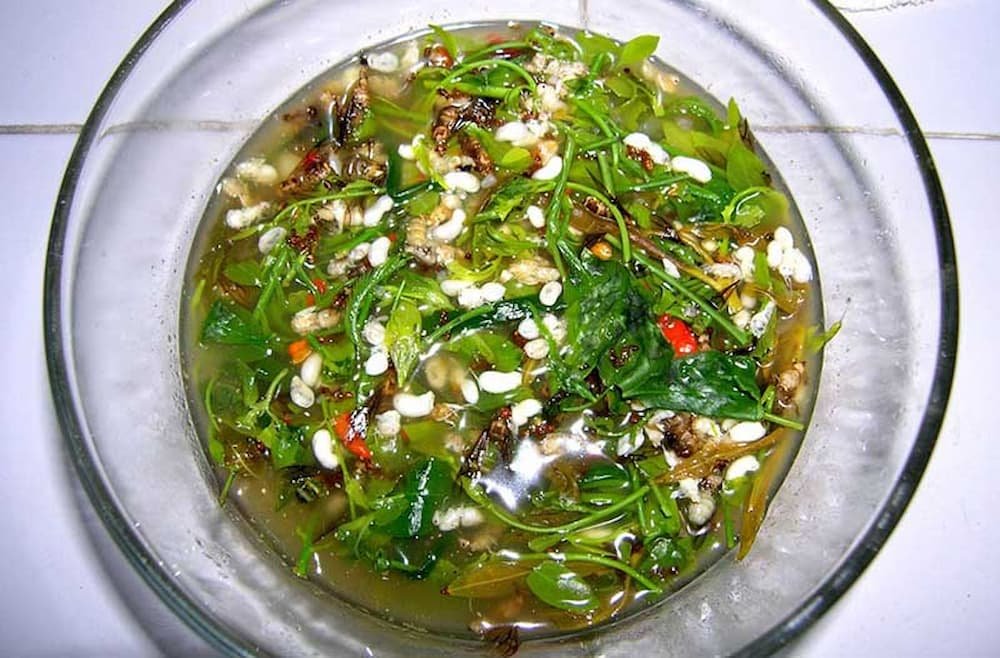Are you up for anything? Got a stomach made of steel? Great, you’ll need it if you are up for eating some of these delicacies. In this article, we feature a selection of 30 of the most unusual foods you can find (and eat) across Asia.
Let’s get started!
Eating horse is quite taboo in many cultures, but in Japan and Korea (especially on the island of Jeju) you can try raw horse meat sashimi. In Japan, it’s called basashi, while in Korea it’s called yuuk-hwe.
According to a Korean Nutrition Society study, horse meat contains high doses of acids and minerals that can be beneficial to your health. Check out ZenKimchi’s post about trying horse and dung-fed pig belly.
This is one that I personally don’t agree with and not something I recommend you try!

When I went to Beijing with some of my friends we sat down in a restaurant and played Russian Roulette with the all-Chinese menu and pointed at some pictures that looked quite good. One of the dishes was really good and tasted a lot like chicken, but had all of these funny bones. In our very limited Mandarin, we tried to ask the waitress what the animal was.
We played charades as we mimicked the behaviors of certain animals. “Was it chicken?” “No”, she shook her head and bounced like a rabbit would do. “A rabbit?” I tried to signal as I bounced and motioned long bunny ears. “No”, she shook her head again. This went on for a while, as we went through all kinds of different animals until she gave us a signal to wait a minute. Moments later she came back with this huge ugly green toad in a net… really ugly, but surprisingly really good.

In Shanghai, my friends and I managed to order a deep-fried pigeon. After a few beers, and because the pigeon was quite small, we decided to draw straws where the loser would have to eat the head. Unfortunately, for me, I drew the shortest straw. I thought, “well bugger this, I may as well eat the whole thing.” And so I ate the head… and the eyes… and the brain… and the dirty, chewy, crunchy, tasteless beak.
Yes, beak and all. Not something I’d recommend.

In China and parts of South East Asia, you can order fried scorpions or grasshoppers on skewers. Be careful though, because my friend kept on getting nosebleeds from eating them. He thinks eating two is OK, but three is when the nosebleeds start to happen. Apparently, frying the scorpion neutralizes the poison. In any case, they’re quite cheap and chewy.

One of the (bad) stereotypes about Korea, is that all Koreans eat dogs. Now, this isn’t really the case, but dog is still a popular delicacy, especially on the hottest days of the year, when spicy dog soup is eaten by a lot of men because apparently, it enhances virility and sexual potency. Before it used to be called ke-go-gi (literally “dog meat”), but many restaurants now call it something different like yong-yang-tang (literally “nourishment soup”).
Definitely not something I condone nor recommend you try!

I personally haven’t tried it… yet, but blood soup is a delicacy in Vietnam, China, and other parts of southeast Asia. Duck blood soup (tiet canh vit) , pork blood soup (tiet canh heo), or blood soup with all of the gizzards and bones that are leftover (can’t let it go to waste) is a good dish to eat/drink when you’re drinking alcohol. Recently Anna tried it in Vietnam, with rice wine (supposedly an aphrodisiac) and Wes got to try some courtesy of his new “friend”.

Pufferfish is an expensive delicacy that has to be tried once in your life. Known as fugu in Japan, and bok in Korea, this infamous deadly delicacy is one of the most expensive and most delicious meals I’ve ever tried. Over the years many people have died from eating pufferfish that hasn’t been prepared properly. The pufferfish is the second most poisonous vertebrate in the world, with its skin and some organs highly toxic to touch or eat.
I had it twice in South Korea, where it was expertly prepared by a master chef who had spent many years in Japan learning the art of preparing the fish correctly. It was about $70USD (70,000 won) per person for a 4-course meal of pufferfish sashimi, boiled pufferfish with mushrooms, battered pufferfish, and pufferfish sushi. I was a little hesitant to try it at first, but after tasting it, It’s definitely worth every cent. Mmmm, pufferfish!

Tong zi dan or Virgin Boy Eggs, is a traditional delicacy of Dongyang, China made by cooking eggs in urine collected from young boys. Urine is collected from school toilets or boys urinate directly into collection buckets set out by vendors. The eggs are soaked and boiled in the urine. The shells are cracked and cooked all day on low heat. Residents believe “the eggs decrease body heat, promote better blood circulation and just generally reinvigorate the body.” In 2008, Dongyang recognized the eggs as a “local intangible cultural heritage.”

Known throughout Southeast Asia as the “King of Fruits”, the durian is distinctive for its size, strong odor, and badass-looking husk. The fruit can grow as large as 30cm (12in) long and weigh up to 3kg (7lb).
After removing the husk, the edible flesh emits a distinctive odor that is strong and penetrating. The smell evokes reactions of intense disgust and has led to the fruit’s banishment from certain hotels and public transportation in Southeast Asia.

Bird’s nests have been used in Chinese cooking for over 400 years, most often as bird’s nest soup. The nests are composed of saliva cement interwoven with small strands, that’s right.. spit!. They take the shape of a small cup stuck to the cave wall and are built during the breeding season by the male swiftlet over a period of 35 days in enormous limestone caves in Borneo. The nests have high levels of calcium, iron, potassium, and magnesium and are among the most expensive animal products consumed by humans, with an average nest selling for $2,500/kg for end-consumers in Asia.

Beondegi is a popular dish in Korea. Beondegi is steamed or boiled silkworm pupae that are seasoned and eaten as a snack. You will find them being served by street vendors, as well as in restaurants and drinking establishments. They are also sold in cans in grocery stores and convenience stores, but they must be boiled in water before serving.

Shark fin soup is a popular Chinese cuisine usually served at special occasions such as weddings or banquets as it is considered a luxury item in Chinese culture. The shark fins provide texture while the taste comes from the other soup ingredients. The soup originated centuries ago when shark fins’ were believed to contain properties to boost sexual potency, enhance skin quality, increase qi or energy, prevent heart disease, and lower cholesterol.
The process of gathering the shark fins is a gruesome one that has drawn criticism from the international community, calling for it to be banned completely. Like the ivory trade in Africa, this is cruelty on a massive scale.
I do not condone the consumption of shark fins.

Drunken shrimp is a popular dish in some parts of China involving fresh-water shrimp that are stunned in a strong liquor (baijiu) and eaten alive. The shrimp are sometimes treated in alcohol and then cooked in boiling water rather than served live.
It is important to note that consuming uncooked shellfish may be a serious health hazard.

If you like honey, perhaps you’ll like the Japanese delicacy, Hachi no Ko or honey bee larvae. Crunchy and full of protein, the bee larvae are eaten for their texture and nutritional value. Legend has it that the Japanese emperor Hirohito’s favorite food was fried wasps over rice with a dash of sugar and soy sauce.

Deep-fried spider is a regional delicacy in Cambodia. In the Cambodian town of Skuon, it has even become a popular attraction for tourists passing through. The spiders are bred in holes in the ground and fried in oil. During the years of Khmer Rouge rule, when food was in short supply, locals began eating the spiders out of pure desperation and hunger. The spiders are a species of tarantula called “a-ping” in Khmer and are about the size of a human palm.

Sannakji is a Korean delicacy of octopus that has been cut into small pieces and served immediately while still alive! The tentacle pieces are still squirming on the plate and are served with sesame oil. Since the suction cups are still active when the dish is served, special care should be taken when eating to avoid them sticking to your mouth or throat.
Nattō is a traditional Japanese food made from fermented soybeans. Mostly eaten as a breakfast food, it is an acquired taste due to its powerful smell, strong flavor, and slimy texture.

Guīlínggāo, also known as Tortoise Jelly, is a jelly-like Chinese medicine that is also sold as a dessert. It was traditionally made from the crushed shell of a turtle combined with a variety of herbal products. It is extremely expensive due to the turtle-derived ingredients, therefore the commercially available guīlínggāo usually does not contain turtle shell powder at all. However, they both share the same herbal additives and are similarly marketed as being good for skin complexion when ingested.

Fancy a cracker that looks like it has been dropped in a wasp’s nest? Are you brave enough to join the “wasp fan club”? In the Japanese town of Omachi, hunters catch digger wasps, boil them up, dry them, then add them to the cracker mix. Makes me concerned that those stingers are just begging to find the inside of my mouth.

White ant eggs are commonly found and utilized as food in Southeast Asia, predominantly in Thailand, Cambodia, and Vietnam. The ants are often piled high and fried, ready to be consumed as a quick snack. One of the weirdest is white ant eggs soup, a mixture of eggs, partial embryos, and baby ants. People say the eggs pop in their mouths, releasing a sour flavor.

Century egg or pidan, is a Chinese cuisine ingredient made by preserving duck, chicken or quail eggs in a mixture of clay, ash, salt, quicklime, and rice hulls for several weeks to several months, depending on the method of processing. Through the process, the yolk becomes a dark green to grey color, with a creamy consistency and an odor of sulfur and ammonia, while the white becomes a dark brown, translucent jelly with salty or little flavor.
Some eggs have patterns near the surface of the egg that resemble pine branches, giving rise to one of its Chinese names, the pine-patterned egg. It is also known as preserved egg, hundred-year egg, thousand-year egg, thousand-year-old egg, and millennium egg.

Pig’s blood cake is a street food delicacy served on a stick from market stalls in Taiwan. It is made with pork blood, sticky rice and soy broth. It is fried or steamed and coated in peanut flour, then eaten as a snack. Keep an eye out for the street vendors who keep it warmed in a wooden box or metal steamer.

Shirako literally translates to “white children” in Japanese. Pretty descriptive considering it is the male equivalent of caviar, yep you guessed it – the male cod fish’s sperm sac. Technically it can come from many different kinds of fish. Shirako is described as tasting “creamy”, “buttery” and “custard-like.” It can be steamed, pan-fried, or deep-fried, but no amount of cooking will take away the uncomfortable silence when you tell your friends what they are eating.

While walking through a Japanese fish market or grocery store, don’t be surprised to see a large tuna eye staring up at you. The taste is a bit like squid and the eyeball comes surrounded by fish fat and severed muscles that are also meant to be quite tasty. To cook, you simply boil it and then season to taste….yum!

Shiokara is a food in Japanese cuisine made from a selection of small meaty offcuts in a brown viscous paste of the animal’s heavily salted, fermented viscera. The raw viscera are mixed with salt and malted rice, packed in a closed container, and fermented for up to a month. The flavor is similar to cured anchovies due to the saltiness only with a different texture. It is quite strong and is considered something of an acquired taste even for the native Japanese palate. One method of enjoying it is to consume the serving at one gulp and to follow it with a shot of straight whiskey.

Balut is a developing duck embryo that is boiled alive and eaten in the shell. It is commonly sold as street food in the Philippines. There are also variations to be found throughout Southeast Asia, in countries such as Laos, Cambodia, and Vietnam. They are generally sold at night and often served with beer… makes sense to do it in the dark with the help of alcohol.
The process involves the top of the egg being cracked open and salt poured into the opening. Then the contents are pushed up from the bottom in one motion, crunching on the beak and feathers ensues.

Originally from Taiwan, stinky tofu is also a popular cuisine in China and some parts of Indonesia. This fermented tofu dish is one of the most pungent smelling, uniquely tasting foods anyone encounters. Even the native Taiwanese have mixed feelings about their regional tofu-based cuisine.

Paniki is a dish from North Sulawesi made from fruit bats, yes that’s right as if bats don’t freak people out enough. The bats are burned to remove their soft hairs, then cooked in coconut milk, herbs, and spices. Paniki is often also cooked in spicy rica-rica, a mixture of various herbs.

Namako, as it is known in Japan, Balatan, in the Philippines, Trepang, in Indonesia – is a sea cucumber. They resemble a large slug and are prolific in the waters of the Pacific Ocean. Most cultures in East and Southeast Asia regard sea cucumbers as a delicacy.
A number of dishes are made with sea cucumber, and in most dishes, it has a slippery texture. It is usually eaten raw or with a vinegar dressing and is considered to have a delicate flavor.

The gonads of both male and female sea urchins, usually called sea urchin roe or corals, are culinary delicacies in many parts of Asia and the world. In Japan, sea urchin is known as uni and is served raw as sashimi or in sushi, with soy sauce and wasabi. After carefully breaking the spiky exterior, the gonads of the sea urchin are scooped out and eaten raw. They have a briny, almost creamy taste and can fetch a high price.

Feel free to tell me your favorite unusual foods of Asia in the comments below.


Philippines has a lot of exotic foods. Thanks for this blog!
bruh
You don't condone eating sharks or dogs, but apparently eating animals/embryos that are boiled alive is ok! Hypocrisy at its best.
you do realize this is Asian food. They are not obligated to confirm to other continents standards on food.
Racism is not ok as a half-white-half asain American your ignorance is not only offense and extremely racist, if your so hateful to Asia never eat our food, visit our countries or buy the products that are manufactured here. Not to mention not every asain eats these foods so it's extremely ignorant to assume these things. I hope you're happy for insulting a whole continent.🖕🏻
You wanna explain how this is ignorant to me? You really shouldn't travel if you get offended by a list about 30 foods that are from a certain part of the world.
And we wonder why Corona-virus is here
Racism is a good thing, as a half asain half white American your ignorance shows. Not everyone is Asia eats these foods . Secondly, the virus originated in China, not that it makes it ok to be racist and hateful toward there people. I hope you learn to think before you speak 🖕🏻
I hope you learn to think before you eat lmao
It's all fun and jokes, ugh maybe you'd realize if you weren't such a boring prick. It becomes a problem when your so politically correct that you cant handle reading an article and can be mad, and horrible but just laugh things off. If reading this article offended you then your right to be questioned. Sure not all of us asians eat this, but you need to be a bit more light about it. Its unhealthy to get mad for these little things. All this is a fucking article, you probably saw it said asain and food and whent straight to the comments, what does that say about you? We may be minority's but we can be light about things. You grew up in america, and yes some of these things are a thing in korea! But she didnt say all asians eat that, she said here are some foods that I think are weird at other countrys. SHES TALKING ABOUT CULTURES NOT ASAINS THEMSELVES. You are the ignorant ones. People used to get mad about racism that was real. THATS WHY NO ONE TAKES RASICM SERIOUSLY ANYMORE.
10/10 ragebait
China's drunk shrimp is really good!
Live shrimps seasoned with spices and cooking wine. Great texture and flavour. The shrimps are small around 3" or 4" in length and they are not saltwater shrimps.
Thanks. I’ll have to try it.
in italy horse and pigeon are not so unusual......visit everything but don't kill just to tell i've been there and i tried this...this is not the point of an intelligent trip